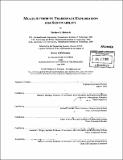| dc.contributor.advisor | Daniel E. Hastings. | en_US |
| dc.contributor.author | Richards, Matthew G | en_US |
| dc.contributor.other | Massachusetts Institute of Technology. Engineering Systems Division. | en_US |
| dc.date.accessioned | 2010-03-25T15:16:20Z | |
| dc.date.available | 2010-03-25T15:16:20Z | |
| dc.date.copyright | 2009 | en_US |
| dc.date.issued | 2009 | en_US |
| dc.identifier.uri | http://hdl.handle.net/1721.1/53217 | |
| dc.description | Thesis (Ph. D.)--Massachusetts Institute of Technology, Engineering Systems Division, 2009. | en_US |
| dc.description | Cataloged from PDF version of thesis. | en_US |
| dc.description | Includes bibliographical references (p. 235-249). | en_US |
| dc.description.abstract | Survivability is the ability of a system to minimize the impact of a finite-duration disturbance on value delivery (i.e., stakeholder benefit at cost), achieved through (1) the reduction of the likelihood or magnitude of a disturbance, (2) the satisfaction of a minimally acceptable level of value delivery during and after a disturbance, and/or (3) a timely recovery. Traditionally specified as a requirement in military systems, survivability is an increasingly important consideration for all engineering systems given the proliferation of natural and artificial threats. Although survivability is an emergent system property that arises from interactions between a system and its environment, conventional approaches to survivability engineering are reductionist in nature. Furthermore, current methods neither accommodate dynamic threat environments nor facilitate stakeholder communication for conducting trade-offs among system lifecycle cost, mission utility, and operational survivability. Multi-Attribute Tradespace Exploration (MATE) for Survivability is introduced as a system analysis methodology to improve the generation and evaluation of survivable alternatives during conceptual design. MATE for Survivability applies decision theory to the parametric modeling of thousands of design alternatives across representative distributions of disturbance environments. To improve the generation of survivable alternatives, seventeen empirically-validated survivability design principles are introduced. The general set of design principles allows the consideration of structural and behavioral strategies for mitigating the impact of disturbances over the lifecycle of a given encounter. | en_US |
| dc.description.abstract | (cont.) To improve the evaluation of survivability, value-based metrics are introduced for the assessment of survivability as a dynamic, continuous, and path-dependent system property. Two of these metrics, time-weighted average utility loss and threshold availability, are used to evaluate survivability based on the relationship between stochastic utility trajectories of system state and stakeholder expectations across nominal and perturbed environments. Finally, the survivability "tear(drop)" tradespace is introduced to enable the identification of inherently survivable architectures that efficiently balance performance metrics of cost, utility, and survivability. The internal validity and prescriptive value of the design principles, metrics, and tradespaces comprising MATE for Survivability are established through applications to the designs of an orbital transfer vehicle and a satellite radar system. | en_US |
| dc.description.statementofresponsibility | by Matthew G. Richards. | en_US |
| dc.format.extent | 297 p. | en_US |
| dc.language.iso | eng | en_US |
| dc.publisher | Massachusetts Institute of Technology | en_US |
| dc.rights | M.I.T. theses are protected by
copyright. They may be viewed from this source for any purpose, but
reproduction or distribution in any format is prohibited without written
permission. See provided URL for inquiries about permission. | en_US |
| dc.rights.uri | http://dspace.mit.edu/handle/1721.1/7582 | en_US |
| dc.subject | Engineering Systems Division. | en_US |
| dc.title | Multi-attribute tradespace exploration for survivability | en_US |
| dc.type | Thesis | en_US |
| dc.description.degree | Ph.D. | en_US |
| dc.contributor.department | Massachusetts Institute of Technology. Engineering Systems Division | |
| dc.identifier.oclc | 528838173 | en_US |
